The Museum Collections
Introduction
I. History and Art Collection
1. Icons of the 14th – 19th centuries
icons of the 14th – 17th century
2. Jewelry art of the 14th – 20th century
jewelry art of the 14th – 17th century
jewelry art of the 18th – 19th century
the european silver 14th - 19th centuries
3. Small-size sculptures (works of metal, wood, bone)
XI – the beginning of the XX century
Small-size sculptures 11th – 17th century
Small-size sculptures 18th – early 20th century
enamel of Troitza masters 15-8th – early 20th century
5.Embroidery, lace, textiles of the 14th - early 20th century
icon and ornamental embroidery
gold and silver lace
6.Painting of the 18th – 21st centuries
painting of the 18th – 19th centuris
painting of the 20th – 21st centuris
II.Manuscripts and old printed books of the 14th – 17th century
IV.Lithography of the 18th – 19th century
V.Numismatics
VI.Medals of the 18th - early 20th century
VIII.Archeology collection
IX. Russian folk and applied and decorative art of the 17th – 21st c.
1. Artistic wood
folk carved and painted wood
wooden toys
house carving of Sergiev Posad
Khokhloma and Gorodets painting
2. Artistic textiles
embroidery and weaving
printed textiles and lace
Russian shawls
folk costumes
folk garments
printed cotton kerchiefs
|
Khokhloma and Gorodets painting(p. 1) |
The Museum collection of Khokhloma and Gorodets is rather extensive, it can be carried to one of the largest. At large it totals more than thousand exhibits executed from a wood, and about four thousand samples Khokhloma and Gorodetz paints on a paper, glass and porcelain.
A wood is one of the most widespread materials in Russia. Special style traditions of its art processing have developed in various regions of the country, including in the Nizhniy Novgorod region where there are widely known crafts of a wood painting - Khokhloma and Gorodets. These oldest centers of traditional national culture are located in northern part of Nizhniy Novgorod’s Zavolzhje, all in several tens km one from another, nevertheless, their art systems are original and are not similar against each other.
The Khokhloma's craft is well-known for wooden ware which attracts attention for a long time by beauty and laconicism of their forms, variety of vegetative patterns and strict solemnity of the colour based on a combination of red, black and golden colour. Singularity of the colouring simulating expensive metal vessels, is reached by original way which here remains within some centuries in the basis. Wooden ware ground a clay solution, impregnate with linen oil, rub with a powder of silvery colour (now it is an aluminum powder, in the past - tin), then paint and varnish. After that there passes training in the furnace at a heat. The varnish gets durability and beautiful amber colouring, and the silvery background appeared through it becomes similar to gold.
Masters of Gorodets, unlike ones of Khokhloma, paint not ware, but wooden panels, caskets, trunks, decorate their festively-solemn scenes of tea drinking, festivals, drivings on the horses, adjoining to images of graceful horses, strange birds and flowers. Embroidery language of this art is based on singularity of images, bright polychromy of coloring and the masterly techniques, the important place in Gorodetsk paints occupy genre plots.
|
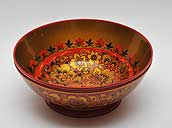
Shvetsova V. K. A cup. 2007. Joint-Stock Company the Hohlomsky painting. Simeonov town. |
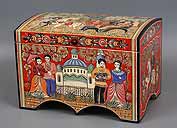
Rukina T.M. the Trunk Driving on a three in Zagorsk. 1997. |
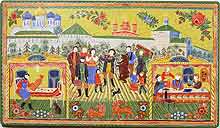
Staroverova E.N. Panel Time. 1997. |
|
A craft of Khokhloma is earlier on the origin. Easy wooden bowls, bratins, saltcellars, painted with vegetative patterns on a gold background, drew attention in 18th century, and in 19th they have got popularity not only in Russia, but also abroad.
Unfortunately, the wooden ware is not durable, and only not numerous samples who can be attributed to a 19th century have remained to now. In collection of Sergiev-Posad museum is only such 12 subjects. In the majority they are simple by form and painting cups, delivery, saltcellars; two scoops for flour, possibly, custom-made and dated 1879 more single out by difficult painting.
The most part of a museum collection of khokhloma paintings are products of 1930th years. At this time masters united in co-operative associations of handicraftsmen. Artels, formed in ancient villages and villages, located on headwaters of Uzola river - New Pokrovsk, Semino, etc., made ware of traditional forms with masterly grass patterns and furniture. Artel "Export" organized those years in Semenov, specialized on release of more difficult by the form and a painting of products – vases & ladles, which most part intended for sale by abroad. Works of the largest masters of that time are stored in museum collection, their names become in history of a craft: A.Serova, I.Bedina, F. and S. Krasilnikovy, I.Tjukalova, A.Podogova, S.Juzikova and others.
|
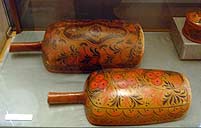
Scoops for a flour. 1879. |
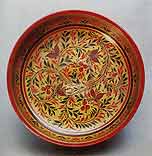
Serov A.M. Bowl. 1930th. New Pokrovsk’s artels of I.V.Stalin. |
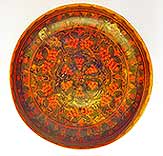
Bedin F.A. Bowl. 1935. New Pokrovsk artels of I.V.Stalin.
|
|
Ňhe thirtieth years for Khokhloma, as well as for many centers of traditional national culture, - search and experiment time. Masters of a craft worked for the first time over creation of the products intended specially for museum and exhibition expositions, decoration public premises, use traditional khokhloma ornaments for dressing of porcelain, glass, develop drawings for fabrics, their searches in the field of a twiddle are interesting. The considerable part of experimental works of 1930th years is stored in Sergiev-Posad museum.
Among the most interesting exhibits of those years’ are samples of furniture with unusual for «khokhloma» a painting on white and silvery backgrounds. It is the complete set for needlework (a table with chairs, master A.G. Podogov) and the screen executed by khokhloma’s masters in experimental workshops of the Museum of national art crafts, opening in the late 1930th at first in Moscow, then in Zagorsk.
|
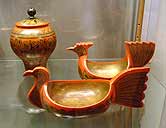
Pot and ladles. Second half of 1930th. |
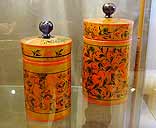
Deliveries. 1930th years. |
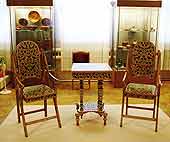
Podogov A.G. Complete set of furniture. The middle of 1930th years. Hrjashchevsky artel Red farmer. |
|


